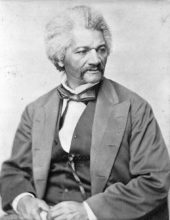
Frederik Douglass
Why John Brown opposed slavery in the way he did is hard to say. We know that as a twelve-year-old, he witnessed a slave boy about his age being severely beaten with an iron fire shovel, which shocked him greatly. We also know that his father, who was involved in the Underground Railroad by providing a safe house to escaped slaves, sent his son to be schooled by an abolitionist. And when John started his own business, he used his work place to hide countless runaway slaves. Still, Brown seems to have been primarily motivated by religious principles during this time of his life, not by fanaticism or political conviction. But he lived in polarized times, which might have triggered his activism, as the following incident indicates. In 1837, a pro-slavery mob attacked and killed minister, journalist and abolitionist Elijah Parish Lovejoy, prompting Brown to claim: “Here, before God, in the presence of these witnesses, from this time, I consecrate my life to the destruction of slavery!”
Inspiration
Six years later Brown and his family moved to Springfield, Massachusetts, a hotspot of the abolitionist movement. He joined the Free Church, where he listened to anti-slavery speeches by renowned abolitionists like Sojourner Truth and Frederick Douglass. It proved to be another pivotal moment in his life. Sojourner Truth was born in to slavery on an estate owned by Dutch settlers and grew up speaking Dutch as her first language. After finding freedom, she travelled the country preaching abolition and equal rights for all women and blacks alike.

Sojourner Truth
It’s unknown whether she ever spoke to John Brown, but Brown did meet Frederik Douglass several times. Douglass was also a former slave, who became a vigorous social reformer, abolitionist, orator, writer and statesman. Their meetings had a profound influence on Douglass. Up until then he had hoped abolition could come about peacefully, but his conversations with Brown made him strongly doubt this. Still, when Brown asked him to join his armed revolt on Harpers Ferry, Douglass was intrigued but refused, believing it was likely to fail and would hurt their cause.
Help and admiration

Historical marker Harriet Tubman, Maryland
A famous abolitionist who did help John Brown with the raid was Harriet Tubman. A former slave herself, she carried out dangerous missions to slave-holding states, freeing hundreds. Tubman was well acquainted with both Douglass and Truth and met John Brown in 1858. Due to her knowledge of escape routes and her contacts in the region, she was able to offer Brown valuable information to plan his assault on Harpers Ferry. She also recruited supporters. It is said that ‘General Tubman’, as John Brown called her, was planning to join the fight, but illness prevented her from going. After John Brown’s death, she claimed that Brown “had done more for her people in dying than hundred men would in living.

Portraits of John Brown and his family at Frederik Douglass’ house
Douglass agreed. Although he had to flee to country temporarily after a letter addressed to him was found among John Brown’s possessions, he often voiced his admiration for Brown: “John Brown began the war that ended American slavery and made this a free Republic. Until this blow was struck, the prospect for freedom was dim, shadowy and uncertain. The irrepressible conflict was one of words, votes and compromises. When John Brown stretched forth his arm the sky was cleared.” Up till this day, a picture of John Brown and his family adorns the hall of Frederick Douglass’ former house in Washington D.C.